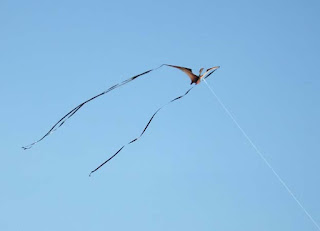This summer I found a kite design by a company called Jurassic Kites. Having sent for one, just for fun, I had go. The design was developed by Sibyl King and it is manufactured by Peterkin UK Ltd.
The kite comes neatly folded in a thin sleeve and is ready harnessed, just needing two pins fixing to brace the wings and a line (supplied) attaching to the harness loop.
Then its up to the top of a windy Knoll - in this case the hills under Thorpe Cloud at Ilam, Derbyshire, UK - Then up it goes.
The first attempt was in low gusty winds and the kite was easily stalled. It took some skill to keep it airborne. With a smaller relative surface area than a conventional kite, this one needs a constant 5+ knot wind ( at least 6 miles per hour) to keep it aloft.
This was no problem as the wind speed increased. At a distance, this is a quite convincing kite. The streamers are needed to stabilise the kite direction. Without them it will loop wildly. I am tempted to try it with shorter wing streamers, but that will wait until I have some lighter ribbons of clear plastic.
With a little more wind, the kite becomes much more stable.
Bringing it down is easy if you peg the cord to the ground and walk along shortening the cord until the kite is near ground level. Much quicker to crash the kite, but I want to fly this one again.
It is years since I seriously flew a kite - What fun.
Wednesday, 14 September 2016
Saturday, 27 August 2016
Gordon Cullen
In 1958, a tile wall mural was commissions for the lower precinct in Coventry. It represented much of the history of the city. The work was undertaken by Gordon Cullen and installed during the redevelopment in 1958.
As part of the mural, there is a wall showing prehistoric creatures. One is a representation of a pterosaur.
This could be of Dimorphodon macronys, though the characteristics are very generalised. It is good to see such a ceramic representation from 1958.
Tuesday, 28 June 2016
Pterosaurs at Liverpool
Having recently visited the Liverpool World Museum to see the cast of Quetzalcoatlus northropi suspended in the Foyer, I saw a number of specimens on display in the galleries. The specimen in the foyer is big and imposing.
In the education centre was a cast of a Tropiognathus skull. This was a substantial sized pterosaur.
A lone Rhamphocephalus bucklandi tooth from the stonesfield slate at Naunton, Gloucestershire was also on display. This is a small, but complete tooth.
Three plaster casts of small Solnhofen pterosaurs from the Lithographic Limestone of Bavaria are displayed along with a wing phalange of Pteranodon, from Kansas in the same display as the Rhamphocephalus tooth.
There is also a phalange from the lithographic limestone of Bavaria that is attributed to Pterodactylus. Both ends are damages, but this seems a good association to me.
There is also a small, but somewhat outdated model of a pterodactylus, of which I do not have a photograph. The World Museum at Liverpool is an excellent visit if you have not been before.
In the education centre was a cast of a Tropiognathus skull. This was a substantial sized pterosaur.
A lone Rhamphocephalus bucklandi tooth from the stonesfield slate at Naunton, Gloucestershire was also on display. This is a small, but complete tooth.
Three plaster casts of small Solnhofen pterosaurs from the Lithographic Limestone of Bavaria are displayed along with a wing phalange of Pteranodon, from Kansas in the same display as the Rhamphocephalus tooth.
There is also a phalange from the lithographic limestone of Bavaria that is attributed to Pterodactylus. Both ends are damages, but this seems a good association to me.
There is also a small, but somewhat outdated model of a pterodactylus, of which I do not have a photograph. The World Museum at Liverpool is an excellent visit if you have not been before.
Subscribe to:
Comments (Atom)














